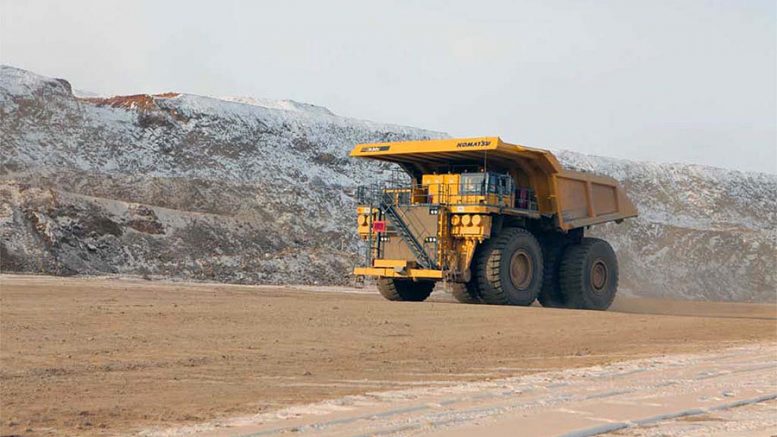Shares of Canada’s Turquoise Hill Resources (TSX: TRQ; NYSE: TRQ) sunk to historic lows in August on news that production from the vast Oyu Tolgoi copper-gold-silver mine in Mongolia could be delayed 16 to 30 months from the original estimate, while the capital cost of the underground expansion (pegged at US$5.3 billion) could cost another US$1.9 billion.
The expanded underground operation was scheduled to begin production in 2020, but it could now happen sometime between May 2022 and June 2023. A final estimate on the time line and cost will be announced later next year.
Oyu Tolgoi, operated by the world’s No. 2 miner, Rio Tinto (NYSE: RIO; LON: RIO), is 66% owned by Toronto-listed Turquoise Hill — in which Rio has a 50.8% controlling stake — and 34% by the Mongolian government.
Some of Rio’s main lenders, including the European Bank for Reconstruction and Development, have already signalled their willingness to provide more funding for the project.
Turquoise Hill, however, hasn’t had the same luck. Its shares have fallen almost 80% over the past year, and since the cost blowout and revealing its Oyu Tolgoi expansion on July 16, they have dropped even more.
At press time the company’s shares traded at 61¢ within a 52-week range of 60¢ and $3.35. At its peak in 2011, Turquoise Hill’s market capitalization stood at nearly $20 billion. Today it sits at roughly $1.23 billion.
On July 31, the company reported a loss of US$736.7 million, or 22¢ a share, in the three months ended June 30, compared with a profit of US$204 million, or 9¢, a year earlier. It attributed the profit estimate miss to an almost US$597-million impairment charge at the cash-generating unit of the Mongolian mine.
Most of the write-down (US$364.7 million) was recorded against “capital works in progress.” Another US$180 million was related to the carrying value of plant and equipment, while Turquoise Hill also wiped US$52 million off the value of its “mineral property interests.”
Some minority investors fear the cost increases at Oyu Tolgoi will force Turquoise Hill to tap its shareholders for extra cash to complete the project, which could provide Rio with a low-cost way to bump up its ownership in the company, and by extension, the Mongolian mine.
While Turquoise Hill has not ruled out an equity raise, it has said that the US$6-billion debt cap on the project finance facility — which could provide an extra US$1.6 billion of lending capacity — is an “arbitrary” figure that could be “reviewed and looked at, with the potential to increase that amount.”
The company has also noted the mine design rethink could lower the estimate of the amount of copper and gold retrievable from Oyu Tolgoi.
“Current information indicates that Oyu Tolgoi mineral reserves will not be materially impacted by the Hugo North mine design options being considered,” Turquoise Hill said. “However, ongoing reviews will be considered as the work progresses.’’
Issues with the underground project first emerged in October 2018, when technical problems caused a nine-month delay to sustainable production.
The companies use block-cave mining at the asset. Although technically challenging, it is deemed one of the most cost-effective mining methods for extracting ore buried deep below the surface.
For block-caving to work, however, weak and fractured rock needs to collapse under pressure from gravity. Rio Tinto CEO Jean-Sébastien Jacques had previously said that rock collapses too easily at Oyu Tolgoi.
“Starting a block cave correctly is critical to its long-term safety and viability. Analysis suggests that the current mine design carries stability risks leading to a number of alternative mine designs being considered, with work currently at the conceptual study phase,” Edward Sterck, an analyst at BMO Capital Markets, said in a note to investors. “The alternative plans may require relocation of critical underground infrastructure and a change in mining sequence.”
Oyu Tolgoi will become the world’s third-biggest copper mine when it is fully operational in the second half of the next decade.


Be the first to comment on "Turquoise Hill faces trouble at Mongolian mine"